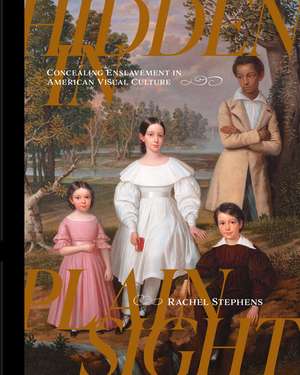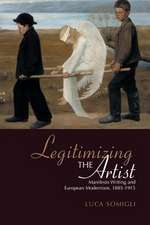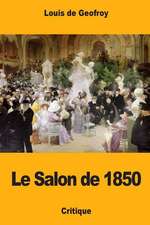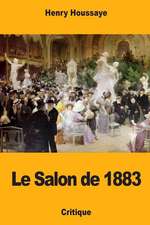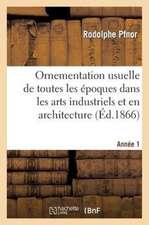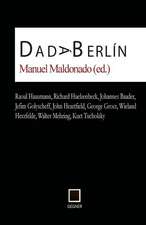Hidden in Plain Sight: Concealing Enslavement in American Visual Culture
Autor Rachel Stephensen Limba Engleză Hardback – 16 aug 2023
In Hidden in Plain Sight: Concealing Enslavement in American Visual Culture, Rachel Stephens addresses an enormous body of material by tracing themes of concealment and silence through paintings, photographs, and ephemera, connecting long overlooked artworks with both the abolitionist materials to which they were responding and archival research across a range of southern historical narratives.
Stephens begins her fascinating study with an examination of the ways that slavery was visually idealized and defended in antebellum art. She then explores the tyranny—especially that depicted in art—enacted by supporters of enslavement, introduces a range of ways that artwork depicting slavery was tangibly concealed, considers photographs of enslaved female caretakers with the white children they reared, and investigates a printmaker’s confidential work in support of the Confederacy. Finally, she delves into an especially pernicious group of proslavery artists in Richmond, Virginia.
Reading visual culture as a key element of the antebellum battle over slavery, Hidden in Plain Sight complicates the existing narratives of American art and history.
Preț: 425.42 lei
Nou
Puncte Express: 638
Preț estimativ în valută:
81.41€ • 87.05$ • 67.87£
81.41€ • 87.05$ • 67.87£
Carte disponibilă
Livrare economică 28 martie-11 aprilie
Preluare comenzi: 021 569.72.76
Specificații
ISBN-13: 9781682262337
ISBN-10: 1682262332
Pagini: 340
Ilustrații: 164 illustrations
Dimensiuni: 241 x 305 x 33 mm
Greutate: 2.4 kg
Editura: University of Arkansas Press
Colecția University of Arkansas Press
ISBN-10: 1682262332
Pagini: 340
Ilustrații: 164 illustrations
Dimensiuni: 241 x 305 x 33 mm
Greutate: 2.4 kg
Editura: University of Arkansas Press
Colecția University of Arkansas Press
Recenzii
“The story of art in service to abolition is common; Rachel Stephens offers a much-needed counterpoint—a consideration of how slavery’s supporters fought back against abolition through visual means. Carefully researched and meticulously written, Hidden in Plain Sight makes a significant contribution to shaping our current understanding of race in America.”
—Naomi H. Slipp, New Bedford Whaling Museum
—Naomi H. Slipp, New Bedford Whaling Museum
Notă biografică
Rachel Stephens is associate professor of art history at the University of Alabama. She is the author of Selling Andrew Jackson: Ralph E. W. Earl and the Politics of Portraiture. In preparing this project, Stephens served as a Tyson Scholar at Crystal Bridges Museum of American Art in the fall of 2018; a fellow at Yale’s Gilder Lehrman Center for the Study of Slavery, Resistance, and Abolition in the spring of 2019; and an Ailsa Mellon Bruce Visiting Senior Fellow at CASVA in the fall of 2020.
Textul de pe ultima copertă
On the cover: Four Children in a Louisiana Landscape, or Bélizaire and the Frey Children, 1837. Oil on canvas. Attributed to Jacques Amans, Courtesy of Jeremy K. Simien.
Even when African Americans were included in portraits, as in the case with Four Children in a Louisiana Landscape, sometimes they were subsequently removed. This work had been owned and kept in storage by the New Orleans Museum of Art since 1972, but in 2004 it was deemed “not relevant” to their mission and deaccessioned. At that time, the painting pictured only three white children, although a shadow of a fourth figure was visible. Subsequent conservation uncovered the titular fourth child: an African American boy leaning against the tree behind the others. Louisiana collector Jeremy K. Simien acquired the painting in 2021, and author Katy Morlas Shannon identified the boy as a fifteen-year-old enslaved house servant named Bélizaire. Bélizaire was born to an enslaved woman named Sally in New Orleans in 1822. Sally and Bélizaire were sold to Frederick Frey, a German merchant and head of Union Bank in New Orleans, in 1828. The portrait was commissioned by Frey in 1837, likely from Jacques Amans, a French portraitist working in New Orleans. Bélizaire was painted over for unknown reasons at some later point. The subsequent uncovering of the figure as well as Bélizaire’s story speaks not only to the concealment of enslavement that long occurred in the South, but also to the possibility and imperative of recovery. The urgency of these ideas is now being recognized by major art museums. The Metropolitan Museum of Art recently acquired the painting, and Bélizaire’s likeness and history will be featured before an international audience despite one-time attempts to erase him.
Even when African Americans were included in portraits, as in the case with Four Children in a Louisiana Landscape, sometimes they were subsequently removed. This work had been owned and kept in storage by the New Orleans Museum of Art since 1972, but in 2004 it was deemed “not relevant” to their mission and deaccessioned. At that time, the painting pictured only three white children, although a shadow of a fourth figure was visible. Subsequent conservation uncovered the titular fourth child: an African American boy leaning against the tree behind the others. Louisiana collector Jeremy K. Simien acquired the painting in 2021, and author Katy Morlas Shannon identified the boy as a fifteen-year-old enslaved house servant named Bélizaire. Bélizaire was born to an enslaved woman named Sally in New Orleans in 1822. Sally and Bélizaire were sold to Frederick Frey, a German merchant and head of Union Bank in New Orleans, in 1828. The portrait was commissioned by Frey in 1837, likely from Jacques Amans, a French portraitist working in New Orleans. Bélizaire was painted over for unknown reasons at some later point. The subsequent uncovering of the figure as well as Bélizaire’s story speaks not only to the concealment of enslavement that long occurred in the South, but also to the possibility and imperative of recovery. The urgency of these ideas is now being recognized by major art museums. The Metropolitan Museum of Art recently acquired the painting, and Bélizaire’s likeness and history will be featured before an international audience despite one-time attempts to erase him.
